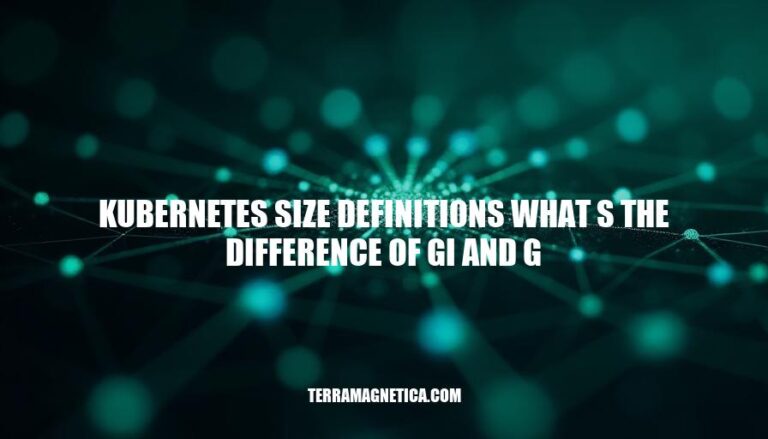


In Kubernetes, understanding size definitions is crucial for effective resource management. The terms ‘Gi’ (Gibibyte) and ‘G’ (Gigabyte) are often used to specify memory and storage. While ‘G’ represents 1 billion bytes, ‘Gi’ represents 1,073,741,824 bytes. This difference can impact how resources are allocated and managed, ensuring that applications run smoothly without unexpected resource shortages.
In Kubernetes, ‘G’ stands for gigabytes (GB) and is based on the decimal system (base 10). Here are some examples of how ‘G’ is used in Kubernetes configurations:
Resource Requests and Limits:
resources:
requests:
memory: "2G"
limits:
memory: "4G"
Persistent Volume Claims:
spec:
resources:
requests:
storage: "10G"
Configuring Memory for Containers:
containers:
- name: my-container
image: my-image
resources:
limits:
memory: "1G"
requests:
memory: "500M"
These configurations specify memory sizes in gigabytes using the ‘G’ suffix.
In Kubernetes, ‘Gi’ stands for gibibytes (GiB), which is based on the binary system (base 2). This means 1 GiB equals (2^{30}) bytes or 1,073,741,824 bytes.
Memory Requests and Limits:
resources:
requests:
memory: "1Gi"
limits:
memory: "2Gi"
This configuration sets a memory request of 1 GiB and a memory limit of 2 GiB for a container.
Persistent Volume Claims:
apiVersion: v1
kind: PersistentVolumeClaim
metadata:
name: my-pvc
spec:
accessModes:
- ReadWriteOnce
resources:
requests:
storage: 10Gi
This claim requests 10 GiB of storage for a persistent volume.
Namespace Resource Quotas:
apiVersion: v1
kind: ResourceQuota
metadata:
name: mem-cpu-quota
spec:
hard:
requests.memory: "1Gi"
limits.memory: "2Gi"
This quota limits the total memory requests to 1 GiB and memory limits to 2 GiB for all pods in a namespace.
In Kubernetes, the key differences between ‘G’ and ‘Gi’ in size definitions are based on their respective base systems: decimal (SI) and binary (IEC).
| Unit | Base System | Size in Bytes | Equivalent in Other Unit |
|---|---|---|---|
| G | Decimal | 1,000,000,000 bytes | ~0.93 GiB |
| Gi | Binary | 1,073,741,824 bytes | ~1.07 GB |
This difference affects actual sizes, with ‘Gi’ being slightly larger than ‘G’ due to the base 2 calculation.
In Kubernetes configurations, ‘g’ stands for gigabytes (GB) and ‘gi’ stands for gibibytes (GiB). The difference between these units can significantly impact resource allocation and management within a Kubernetes cluster.
Precision in Resource Requests and Limits:
Consistency in Resource Management:
Impact on Scheduling and Performance:
Choosing ‘gi’ over ‘g’ for memory-related configurations in Kubernetes can lead to more accurate resource allocation, better consistency in resource management, and improved cluster performance and stability.
The Kubernetes ecosystem uses two distinct base systems for size definitions: decimal (SI) and binary (IEC). The primary distinction between ‘G’ and ‘Gi’ lies in their respective base systems, with ‘G’ employing the decimal system and ‘Gi’ utilizing the binary system. This disparity affects actual sizes, as ‘Gi’ is slightly larger than ‘G’. In Kubernetes configurations, ‘g’ represents gigabytes (GB), while ‘gi’ denotes gibibytes (GiB).
The difference between these units can significantly impact resource allocation and management within a Kubernetes cluster.
Using the correct unit is crucial for efficient resource management in Kubernetes. ‘Gi’ provides more precise memory allocation because it aligns with binary computation, which is how computer memory is actually measured. This precision can help avoid over-allocating resources, leading to a more efficient use of cluster resources.
Consistency in using ‘gi’ for memory ensures that resource requests and limits are accurately represented and managed, reducing the risk of resource contention and improving overall cluster stability. Using ‘g’ may lead to slight underestimation of memory usage, potentially causing pods to be scheduled on nodes with insufficient memory, leading to performance degradation or pod eviction.
Choosing ‘gi’ over ‘g’ for memory-related configurations in Kubernetes can lead to more accurate resource allocation, better consistency in resource management, and improved cluster performance and stability. Therefore, it is essential to correctly use these definitions to ensure efficient resource management in Kubernetes.